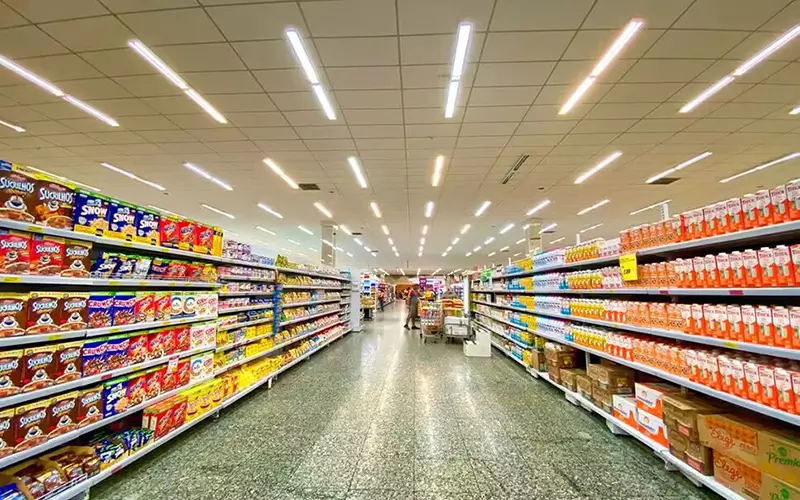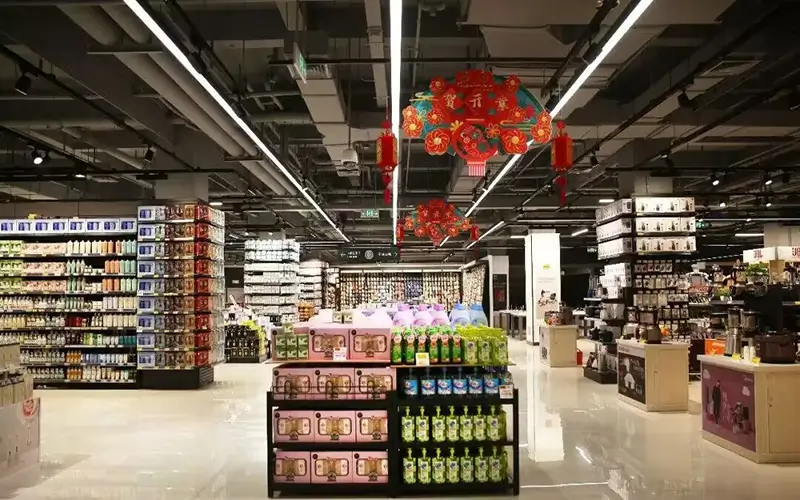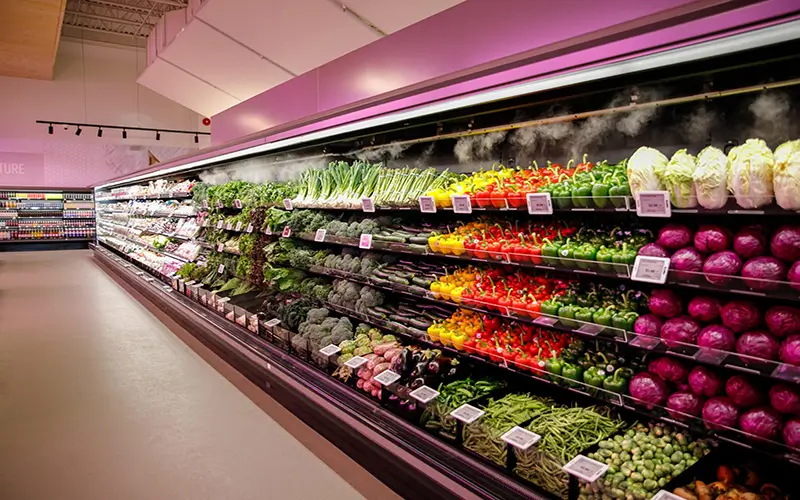
Supermarket lighting plays a decisive role in enhancing the shopping experience of customers. It not only provides lighting for customers. Creating an inviting atmosphere that highlights the product and influences customer behavior simultaneously.
Careful design extends to every section of the supermarket. Some area designs require adequate lighting. Important or prominent products require accent lighting for lighting. However, some areas require supplementary lighting to increase customer interest in the product.
In this article, we will explore what is the role of supermarket lighting and its importance, and provide useful lighting solutions for choosing the right lighting solution.
What is Supermarket Lighting?
Supermarket lighting refers to lighting systems used in retail stores. The main purpose is to raise awareness and create an attractive shopping atmosphere. Therefore, it is necessary to systematically plan the location of the lights.
For example, use LED bulbs, LED downlights, and LED strips to effectively illuminate the entire store. The goal was to create a well-lit space that not only showcases products but also guides customers through the different areas.
The Importance of Supermarket Lighting
Appropriate supermarket lighting will enhance customer shopping comfort. While shopping, it will increase customer satisfaction. There are several important uses of supermarket lighting as follows.

- First, it improves visibility, allowing customers to easily find products and read price tags.
- Plus, proper lighting can help reduce eye strain and enhance the overall shopping experience.
- Second, it influences customer behavior by highlighting a particular area or product, thereby increasing sales.
- Finally, supermarket lighting helps enhance the aesthetics of a store, creating a welcoming environment that encourages customers to stay longer and explore more.
In supermarket lighting, bright displays and accent lighting draw attention to promotions and specials, influencing buying decisions.
How to Choose the Right Lights for Supermarket Lighting?
When choosing lighting fixtures for your supermarket, you need to consider several factors. They help you make better decisions.
- Brightness: Supermarkets need bright lighting to ensure customers can see products clearly.
- Color Temperature: We need to carefully choose the color temperature to create a warm atmosphere. A warmer color temperature such as 3000K creates a cozy ambience for the product. Whereas cooler color temperatures (around 4000K-6000K) provide a brighter, more vibrant feel.
- Energy Efficiency: Opting for LED energy-saving lights is preferred due to the large space in the supermarket. Mainly reducing energy consumption and lowering utility costs.
- CRI (Color Rendering Index): High CRI lights (90+ CRI) can ensure that products appear vibrant and truly present their natural colors. Such as fruits, fresh goods, etc., will directly affect customers’ purchasing decisions.
- Durability: The supermarket operates for a long time and requires continuous use of lighting. Therefore, it is necessary to choose durable and long-life lighting to reduce the cost of replacement.
- Maintenance: Considering later maintenance issues is crucial for the supermarket due to its large space. So choose a lighting solution that minimizes labor costs and reduces maintenance needs.
How are LED Strip Lights Used in Supermarket Lighting?
LED strips are gaining popularity in supermarket lighting due to their versatility and flexibility. Here are some common applications of LED strip lights in supermarkets:
Shelf Lighting
LED strip lights can provide concentrated and uniform lighting. Installing it along the edge or bottom of the shelf facilitates faster product location for customers.

Aisle Lighting
Install LED strips on the edge of the aisle or hang them from the ceiling to provide ambient lighting. This ensures that the entire aisle is well-lit, and even lighting also contributes to a pleasant shopping experience.
Accent Lighting
Use LED strips for accent lighting, highlighting product features, and promoting products. Thereby attracting people’s attention to a specific area or product in the supermarket. This is especially effective for boosting sales and promoting new or seasonal products.
Display Lighting
Illuminate product displays and enhance their visual appeal with widely used LED strips. Especially fresh produce areas, bakery displays,s or deli counters. Place LED strips strategically to highlight and enhance the attractiveness of the product. The ability to choose different color temperatures adds to the versatility.
Signage Lighting
LED strips are used for signage and banners in supermarkets. Can effectively convey important information to customers. LED strip lights add a vibrant glow to the signage, making it more eye-catching and eye-catching.
In short, LED strip lights are widely used in supermarket lighting, mainly for shelf lighting, aisle lighting, accent lighting, display lighting, and sign lighting. LED strip lights have become the first choice of supermarket owners looking to create an inviting shopping environment.
How is LED Neon Flex Used in Supermarket Lighting?
LED neon flex is popular for its unique aesthetic and versatility. The following are common applications of LED neon flex in supermarkets:
Decorative Lighting
LED neon flex is mainly used for decorative lighting. Create eye-catching visual elements within the supermarket. And, it can be bent and shaped to fit a variety of spaces, making it ideal for emphasizing architectural features. Adds a touch of elegance and modernity to the overall vibe of the store.

Signage and Branding
LED neon flex is a popular choice for creating illuminated signage and brand logos in supermarkets. Whether it’s a store name or a directional sign, LED flexible neon signs provide a bold and engaging lighting solution.
Considerations When Choosing Lighting for Supermarkets
Energy consumption from lighting in supermarkets accounts for approximately 25% of total electricity consumption. Using suitable and energy-efficient LED luminaires will be the right decision.
- Lighting preference depends on the type of ceiling in the supermarket. Surface mount, recessed or track lighting fixtures can be used for supermarket lighting.
- Vertical lighting is just as important as horizontal lighting, as products are displayed on shelves.
- The height of the suspended ceiling of the supermarket and the calculated height of the lamp center are used to select the lamps and lanterns.
- High-top supermarkets should use effective spotlights. Because the area under the spotlight will undoubtedly attract the attention of customers.
- The store is illuminated with warm lighting close to yellow, which makes customers feel at home. But white and luminescent colors that are close to blue will give people a fresher and clearer feeling.
Summary
Choosing the right lighting for your supermarket is very important. Which can create a warm shopping environment and enhance the overall customer experience. LED strip lights and LED neon flex are one of popular lighting solutions in supermarkets. They add a touch of decoration to the supermarket while creating a warm atmosphere.
When choosing lighting for a supermarket, color uniformity and harmony must be ensured. And consider lighting control, safety, and longevity. Good lighting not only highlights products but also influences customer behavior and increases sales.
FAQs
Supermarkets have a large space and require bright lighting. This ensures that the product is clearly visible. Lighting levels are typically around 50-100 foot candles (500-1000 lux) for general areas and higher for specific displays.
Yes, LED lights are an excellent choice for supermarket lighting. They offer advantages such as high energy efficiency, long service life, and versatility.
To achieve even lighting in your supermarket, consider the position, spacing, and beam angle of the luminaires. Properly designed lighting layouts and the use of lighting control systems help ensure even lighting.
Yes, implementing a lighting control system can adjust the brightness and color temperature of lighting in different areas, at different times of the day, or during promotional events.
To highlight specific products or displays, use accent lighting. Direct focused light onto desired areas or use lighting fixtures with narrow beam angles to draw attention.
